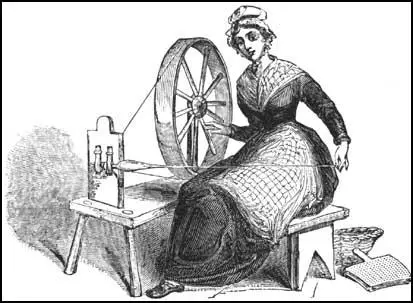Carding
In the 18th Century the production of textiles was the most important industry in Britain. Most of the work was carried out in the home and was often combined with farming. There were three main stages to making cloth: carding, spinning and weaving.
Carding was usually done by children. This involved using a hand-card that removed and untangled the short fibres from the mass. Hand cards were essentially wooden blocks fitted with handles and covered with short metal spikes. The spikes were angled and set in leather. The fibres were worked between the spikes and, be reversing the cards, scrapped off in rolls (cardings) about 12 inches long and just under an inch thick.

appeared in 1835. Her hand-cards are on the floor.
Edward Baines pointed out: "Carding is the process to which the cotton is subjected after it has been opened and cleaned, in order that the fibres of the wool may be disentangled, straightened, and laid parallel with each other. This was formerly effected by instruments called hand-cards, which were brushes made of short pieces of wire, instead of bristles; the wires being struck into a sheet of leather, at a certain angle, and the leather fastened on a flat piece of wood, about twelve inches long and five wide, with a handle. The cotton being spread upon one of the cards, it was repeatedly combed with another till all the fibres were laid straight, when it was stripped off the card in a fleecy roll ready for the rover."
The mother, operating a spinning wheel, turned these cardings into a continuous thread (yarn). Finally, the father used a handloom to weave the yarn into cloth. Daniel Defoe, the author of A Tour Through the Whole Island of Great Britain (1724) "Among the manufacturers' houses are likewise scattered an infinite number of cottages or small dwellings, in which dwell the workmen which are employed, the women and children of whom, are always busy carding, spinning, etc. so that no hands being unemployed all can gain their bread, even from the youngest to the ancient; anyone above four years old works."
Primary Sources
(1) Daniel Defoe, A Tour Through the Whole Island of Great Britain (1724)
Among the manufacturers' houses are likewise scattered an infinite number of cottages or small dwellings, in which dwell the workmen which are employed, the women and children of whom, are always busy carding, spinning, etc. so that no hands being unemployed all can gain their bread, even from the youngest to the ancient; anyone above four years old works.
(2) Edward Baines, The History of the Cotton Manufacture (1835)
Carding is the process to which the cotton is subjected after it has been opened and cleaned, in order that the fibres of the wool may be disentangled, straightened, and laid parallel with each other. This was formerly effected by instruments called hand-cards, which were brushes made of short pieces of wire, instead of bristles; the wires being struck into a sheet of leather, at a certain angle, and the leather fastened on a flat piece of wood, about twelve inches long and five wide, with a handle. The cotton being spread upon one of the cards, it was repeatedly combed with another till all the fibres were laid straight, when it was stripped off the card in a fleecy roll ready for the rover.
(3) Richard Guest, History of Cotton Manufacture (1823)
The spinner took the took the short fleecy rolls in which the cotton was stripped off the hand-cards, applied them successfully to the spindle, and, whilst with one hand she turned the wheel, and thus made the spindle revolve, with the other she drew out the cardings.
